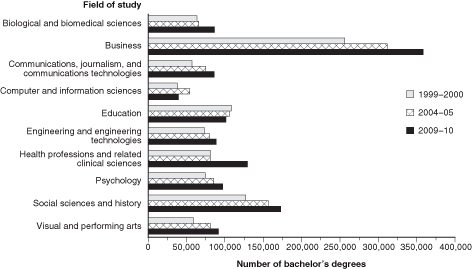According to the National Center for Education Statistics, the average cost of a four-year university degree in the U.S. has increased nearly 250% since 1980. While college graduates still earn more over their lifetimes than those with only high school diplomas, research has shown that a college degree no longer guarantees landing a high-paying job in today’s difficult job market.
The return on having a college degree depends on one’s course of study. A 2011 report from Georgetown University found that median earnings for early childhood education majors were $36,000, while petroleum engineering majors saw median earnings of $120,000. While many college graduates have struggled to find suitable work, the lack of entry-level positions for humanities majors, coupled with high student debt, prompted a Forbes contributor to suggest “eliminating the departments that offer majors that employers do not value” — such as zoology, anthropology, philosophy, art history and humanities — from higher education altogether.
Despite their value in the workplace, majors in science, technology, engineering and math — known as the STEM disciplines — remain less popular than those in the humanities and social sciences. The resulting labor shortages in crucial fields have prompted the White House to create an initiative to produce a million additional STEM graduates by 2022. Others argue that the problem is not a talent gap, but a wage gap, with STEM graduates taking higher-paying jobs in finance and consulting rather than in the sciences.
For a sense of the most popular majors, see data from the government’s National Center for Education Statistics:

One way for students to combine the popularity of humanities degrees with employment benefits of STEM study is to have a second major. A 2012 study from Vanderbilt University’s Curb Center for Art, Enterprise and Public Policy, “Double Majors: Influences, Identities and Impacts,” examined who chooses to double major, motivations behind the choice, popular double major subject pairs, and how double majoring influences college and post-college experiences. The researchers surveyed 1,760 undergraduate students at nine colleges and universities, supplemented by group interviews or small structured discussions, more than 250 undergraduate transcripts, and additional large-scale survey data.
Key study findings include:
- Post-graduation earnings vary widely for double majors. A STEM major, either as a single major or part of a double major, fare appreciably better than other double major combinations. Students double majoring in engineering and natural sciences earned an average starting salary of $78,342; those double majoring in education and a social science earned $45,491.
- Choosing a second major perceived as “high status” — such as economics or one of the sciences — was a way for students to gain more prestige. When presenting themselves to employers or parents, the typical double major student tended to focus on the higher-status major; when reflecting on their core identity, however, he or she frequently identified more strongly with the lower-status choice.
- “Many students choose a humanistic discipline or a foreign language [second major] only after they have a more “practical” discipline under their belts. Were the trend in double majoring to decline … the humanities and foreign languages would likely experience fewer majors and possibly decreased enrollments.” Only 1.7% of single majors chose to study a foreign language, while 10.5% of double majors studied it.
- Students reported that having two majors helped foster creative problem-solving strategies, and those with one major in the arts or humanities reaped the most benefits. However, most institutional structures did not or were unable to provide adequate support for double majors.
- Double majoring has increased more than 10% at the more selective schools, with some schools reporting that 30% to 40% of their undergraduates are double majors. However, African-Americans choose to double major at a significantly lower rate than white, Asian or Latino students; a student’s socioeconomic status can also adversely impact his or her opportunity to pursue a double major.
- Men and women were equally likely to double major, though their choices of majors differed: men chose majors in economics and a science, and women chose majors in a social science and a foreign language.
- “Students are generally interested in picking two majors that complement one another, where there is overlap in requirements and where the two combined majors better prepare them to be competitive in their careers.… Double majors gravitate toward business-related majors; economics and business administration are popular choices.” A second major may also be an expression of the student’s identity, connecting them to personal interests or experiences.
The authors suggest that further institutional support is needed to foster the growth of double majoring: “Higher education leaders need to … formulate policies that overcome learning obstacles and expand opportunities afforded by double majoring for different groups of students.”
Keywords: training, technology, youth, consumer affairs, science, higher education


Expert Commentary